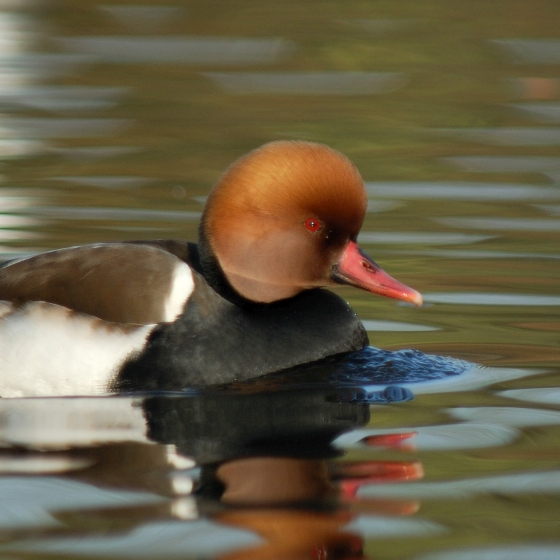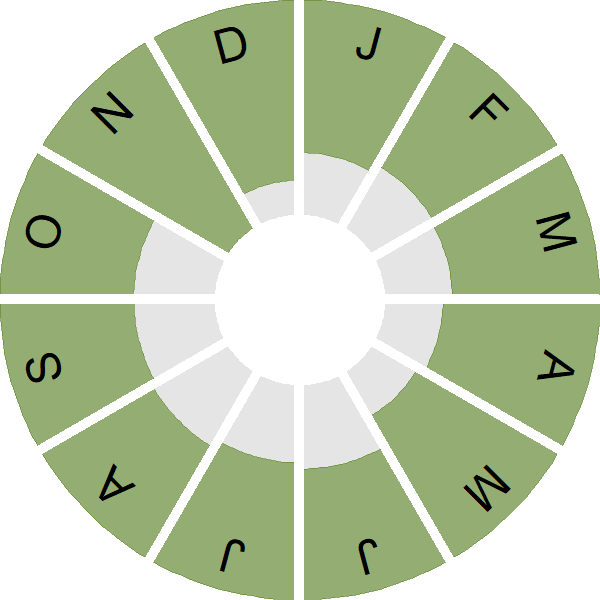Red-crested Pochard

Introduction
The handsome male Red-crested Pochard has a rather large, round, rusty-orange head and coral-red bill whilst the pale-cheeked female is more subdued.
It is highly possible that a few of the Red-crested Pochards seen in the UK have arrived from the European breeding population. However, due to its striking plumage, this is a species that is widely kept in captivity and it may be that most of the birds at large have a captive origin.
The Red-crested Pochard is established as a breeding bird in Britain, with Wetland Bird Survey data pointing to the Cotswold Water park as the main UK site, with over 200 birds regularly counted. The winter population is estimated to be around 600 individuals.

Key Stats
Identification
Songs and Calls
Call:
Status and Trends
Conservation Status
Population Change
Red-crested Pochard has a wide but scattered distribution around the UK. Whilst small numbers of wild birds from continental Europe probably occur, most of the birds observed in the UK come from naturalised breeding populations with the main population originating from the Cotswold Water Park (Lever 2009). Numbers have increased and there has also been a substantial increase in the breeding range distribution since the 1968–72 Atlas (Balmer et al.2013).
Distribution
There is a naturalised, self-sustaining population of Red-crested Pochards, centred on the Cotswold Water Park on the Gloucestershire/Wiltshire border. In winter, Red-crested Pochards are widely distributed in south and central England, where they are found mainly in freshwater habitats.
Occupied 10-km squares in UK
2007/08–10/11
or view it on Bird Atlas Mapstore.
2008–11
or view it on Bird Atlas Mapstore.
European Distribution Map
Distribution Change
Red-crested Pochards have undergone a large range expansion over the last 40 years.
Change in occupied 10-km squares in the UK
from 1981–84 to 2007–11
or view it on Bird Atlas Mapstore.
from 1968–72 to 2008–11
or view it on Bird Atlas Mapstore.
Seasonality
Red-crested Pochards are localised residents, recorded on less than 1% of complete lists.
Weekly pattern of occurrence
The graph shows when the species is present in the UK, with taller bars indicating a higher likelihood of encountering the species in appropriate regions and habitats.

Movement
Britain & Ireland movement
Foreign locations of birds ringed or recovered in Britain & Ireland
Dots show the foreign destinations of birds ringed in Britain & Ireland, and the origins of birds ringed overseas that were subsequently recaptured, resighted or found dead in Britain & Ireland. Dot colours indicate the time of year that the species was present at the location.
- Winter (Nov-Feb)
- Spring (Mar-Apr)
- Summer (May-Jul)
- Autumn (Aug-Oct)

European movements
EuroBirdPortal uses birdwatcher's records, such as those logged in BirdTrack to map the flows of birds as they arrive and depart Europe. See maps for this species here.
The Eurasian-African Migration Atlas shows movements of individual birds ringed or recovered in Europe. See maps for this species here.
Biology
Survival and Longevity
Survival is shown as the proportion of birds surviving from one year to the next and is derived from bird ringing data. It can also be used to estimate how long birds typically live.
View number ringed each year in the Online Ringing Report.
Lifespan
Classification, names and codes
Classification and Codes
- Order: Anseriformes
- Family: Anatidae
- Scientific name: Netta rufina
- Authority: Pallas, 1773
- BTO 2-letter code: RQ
- BTO 5-letter code: RECPO
- Euring code number: 1960
Alternate species names
- Catalan: xibec comú
- Czech: zrzohlávka rudozobá
- Danish: Rødhovedet And
- Dutch: Krooneend
- Estonian: punanokk-vart
- Finnish: punapäänarsku
- French: Nette rousse
- German: Kolbenente
- Hungarian: üstökösréce
- Icelandic: Kólfönd
- Irish: Póiseard Cíordhearg
- Italian: Fistione turco
- Latvian: lielgalvis
- Lithuanian: šalmine antis
- Norwegian: Rødhodeand
- Polish: helmiatka (zwyczajna)
- Portuguese: pato-de-bico-vermelho
- Slovak: hrdzavka potápavá
- Slovenian: tatarska žvižgavka
- Spanish: Pato colorado
- Swedish: rödhuvad dykand
- Welsh: Hwyaden Gribgoch
Research
Causes of Change and Solutions
Causes of change
The main drivers of the increases in this species are uncertain, but the naturalised population has arisen from captive birds. Numbers remain relatively small and it is unclear whether this species will fill an ecological niche which will enable it to increase further and become more widespread.
More Evidence
More evidence from Conservation Evidence.com
Partners
Citing BirdFacts
If you wish to cite particular content in this page (e.g. a specific value) it is best to use the original sources as linked in the page. For a more general citation of the whole page please use: BTO (20XX) BirdFacts Species: profiles of birds occurring in the United Kingdom. BTO, Thetford (www.bto.org/birdfacts, accessed on xx/xx/xxxx).

